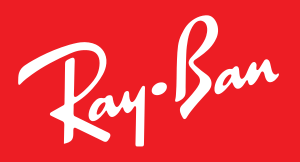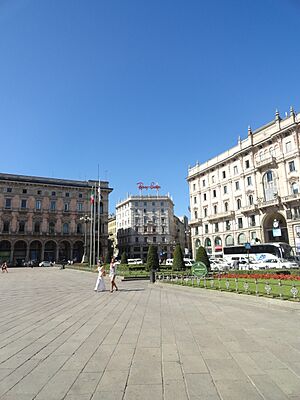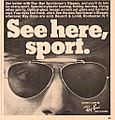Ray-Ban facts for kids
 |
|

Headquarters in Milan, Italy
|
|
| Subsidiary | |
| Industry | Eyewear |
| Founded | 1936 in Rochester, New York, United States |
| Headquarters |
,
Italy
|
|
Area served
|
Worldwide |
| Products | |
| Parent | Luxottica Group |
Ray-Ban is a famous brand that makes stylish sunglasses and eyeglasses. It was started in 1936 by a company called Bausch & Lomb. Ray-Ban is super well-known for its cool Wayfarer and Aviator sunglasses. In 1999, Bausch & Lomb sold Ray-Ban to an Italian company called Luxottica Group for a lot of money.
Contents
The Story of Ray-Ban Sunglasses
How Ray-Ban Started
The idea for Ray-Ban sunglasses began in 1929. A US Army Air Corps Colonel named John A. Macready worked with Bausch & Lomb. This company made medical equipment in Rochester, New York. Colonel Macready wanted special sunglasses for pilots. He needed glasses that would stop the bright glare from the sky. This glare made it hard for pilots to see clearly.
Pilots also had a problem with their goggles fogging up high in the sky. In 1936, they made a first pair of glasses called "Anti-Glare." These glasses had plastic frames and green lenses. They could block out bright light without making it hard to see. The name "Ray-Ban" came from how these glasses could "ban" harmful light rays. This included UV rays and infra-red rays.
Improving the Design
In 1938, they added lenses that could handle impacts better. The next year, the sunglasses got a new metal frame. They were then patented as the Ray-Ban Aviator. The BBC said these glasses used "Kalichrome lenses." These lenses were special. They made details sharper and reduced haze. They did this by filtering out blue light. This made them perfect for flying in misty weather.
In 2025, a famous artist named ASAP Rocky became the first-ever creative director for Ray-Ban. This means he helps decide the brand's style.
Popular Ray-Ban Styles
Classic Sunglasses
Ray-Ban has many popular sunglasses styles. The most famous are the Wayfarer, Erika], and Aviator models. In the 1950s, Ray-Ban also made the Echelon, which had a more square shape.
In 1965, the Olympian I and II sunglasses came out. They became very popular after actor Peter Fonda wore them in the 1969 movie Easy Rider. Ray-Ban has also made special edition glasses. One example is The General from 1987. These looked like the original aviators worn by General Douglas MacArthur during Second World War.
The Clubmaster and More
In the 1980s, the Ray-Ban Clubmaster was added. The Clubmaster has a unique browline frame. It became the third best-selling sunglasses style of the 1980s. Only the Wayfarer and Aviator sold more.
Glasses for Kids
In 2007, Luxottica Group launched Ray-Ban Youth. This was a collection of prescription glasses for kids aged eight to twelve. These glasses looked like popular adult Ray-Ban styles. They were made from strong, allergy-friendly titanium. They also had sturdy hinges and came in many colors.
New Technologies
In 2009, Luxottica released the Ray-Ban Tech collection. This included the Carbon Fibre line. These sunglasses were tested to be very strong and light. They had special polarized lenses made of polycarbonate or crystal.
Ray-Ban also lets you design your own glasses on their website. You can pick different frames, lenses, and even add engravings.
Smart Glasses
In 2021, Ray-Ban created smart glasses with Facebook Reality Labs. They called them Ray-Ban Stories. These glasses have a camera built-in and Bluetooth earphones. They let you take photos and videos or listen to music. Like other smart devices with cameras, people have talked about privacy when using them.
Stopping Fake Ray-Bans
The Problem with Fakes
Ray-Ban is a luxury brand, so fake versions are often made. You might see ads for Ray-Bans at very low prices. These ads often lead to websites selling fake products. Studies show that many ads for cheap luxury items online link to these fake sites.
Fake Ray-Bans are often found when police stop illegal goods. For example, in 2016, police in Thailand found hundreds of thousands of fake sunglasses. These included fake Ray-Bans. The people selling them put fake tags on them to trick buyers.
How Ray-Ban Fights Fakes
Luxottica, the company that owns Ray-Ban, works hard to stop fake products. They changed their website in India to sell products directly. They also take legal action against online stores that sell fake Ray-Bans.
In 2016, Luxottica started a "Minimum Advertised Price (MAP)" rule for stores that sell their products. This rule doesn't say a specific lowest price. But it stops stores from advertising Ray-Ban products at huge discounts. This helps make sure the products keep their value.
Gallery
Images for kids
See also
 In Spanish: Ray-Ban para niños
In Spanish: Ray-Ban para niños
- Persol
- Warby Parker
- Oliver Goldsmith
- Gentle Monster











